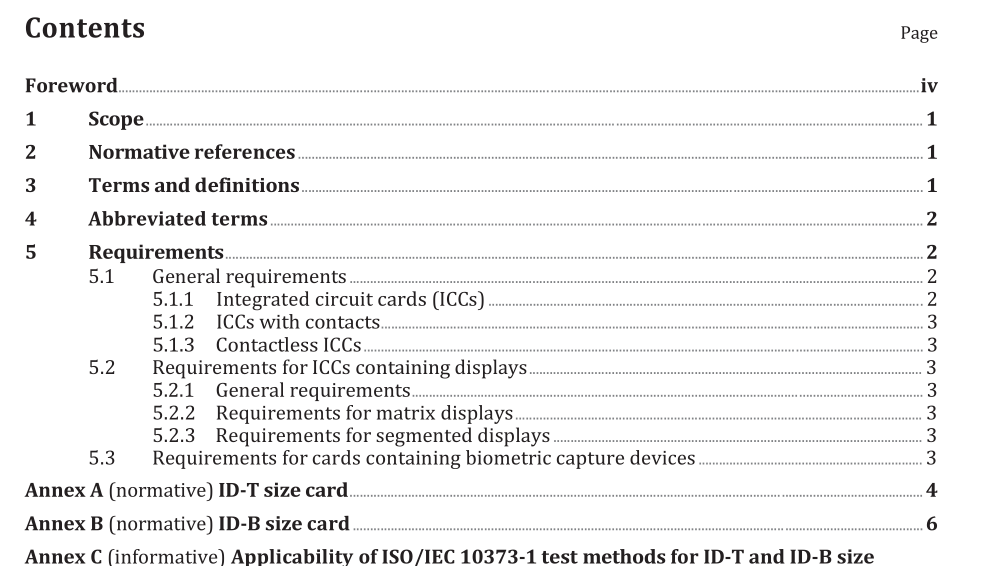ISO IEC 18328-2-2021 pdf Identification cards — ICC-managed devices — Part 2: Physical characteristics and test methods for cards with devices

3.2 ID-B nominally 85,60 mm (3.370 in) wide by 53,98 mm (2.125 in) high with a thickness between 0,84 mm and 2,25 mm (between 0.033 in and 0.089 in) 3.3 ID-T nominally 85,60 mm (3.370 in) wide by 53,98 mm (2.125 in) high with a thickness between 2,25 mm and 3,25 mm (between 0.089 in and 0.128 in) 3.4 machine-readable zone MRZ fixed dimensional area located on an identity card, containing mandatory and optional data formatted for machine reading using optical character recognition (OCR) methods 3.5 new device device to be integrated in the card, except for existing technology, e.g. displays, sensors, microphones, loudspeaker, buttons and keypads 3.6 total display area total area of the ICC related to the display Note 1 to entry: The total display area typically extends beyond the active display area ( 3.1).
5.1.2 ICCs with contacts ICCs with contacts shall in addition meet the requirements specified in ISO/IEC 7816-1. 5.1.3 Contactless ICCs Contactless ICCs shall in addition meet the requirement specified in ISO/IEC 14443-1. Note that for ID-T cards the requirements specified differently from ISO/IEC 7810 in Annex A and for ID-B cards the requirements specified differently from ISO/IEC 7810 in Annex B shall apply. 5.2 Requirements for ICCs containing displays 5.2.1 General requirements The requirements specified in 5.2.2 and 5.2.3 apply to ICCs containing electronic displays. NOTE 1 The requirements described in this document are preliminary. The detailed requirements for ICCs containing electronic displays depend on the specific use-case. NOTE 2 Readability and contrast: An observer’s ability to perceive the information from an electronic display depends on two major factors. These are (a) size and font of the displayed information in relationship to the viewing position and (b) the optical contrast of the displayed information to the surrounding environment. Optical contrast is the comparison of the brightness or sterance of the display to the brightness of the surrounding environment. High readability results by optimizing specific contrast ratios. 5.2.2 Requirements for matrix displays In addition to the test requirements in 5.2.1 , for ICCs with matrix displays, it is required that not less than a defined percentage of all pixels remain functional after the test, as specified by the application. 5.2.3 Requirements for segmented displays In addition to the test requirements in 5.2.1 , for ICCs with segmented displays, no segment failure (dead segment) is allowed, i.e. after the test all segments should be working in both directions from white to black and from black to white.
- Previous:ISO IEC 19770-11-2021 pdf Information technology — IT asset management — Part 11: Requirements for bodies providing audit and certification of IT asset management systems
- Next:ISO IEC 17991-2021 pdf Information technology — Office equipment — Method for measuring scanning productivity of digital scanning devices
- ISO IEC 27050-4-2021 pdf Information technology — Electronic discovery — Part 4: Technical readiness
- ISO IEC 27036-1-2021 pdf Cybersecurity — Supplier relationships — Part 1: Overview and concepts
- ISO IEC 27013-2021 pdf Information security, cybersecurity and privacy protection — Guidance on the integrated implementation of ISO/IEC 27001 and ISO/IEC 20000-1
- ISO IEC 26580-2021 pdf Software and systems engineering — Methods and tools for the feature- based approach to software and systems product line engineering
- ISO IEC 24735-2021 pdf Information technology — Office equipment — Method for measuring digital copying productivity
- ISO IEC 24711-2021 pdf Information technology — Office equipment — Method for the determination of ink cartridge yield for colour inkjet printers and multi- function devices that contain printer components
- ISO IEC 23544-2021 pdf Information Technology — Data centres — Application Platform Energy Effectiveness (APEE)
- ISO IEC 23510-2021 pdf Information technology — 3D printing and scanning — Framework for an Additive Manufacturing Service Platform (AMSP)
- ISO IEC 23127-1-2021 pdf Information technology — Learning, education, and training — Metadata for facilitators of online learning — Part 1: Framework
- ISO IEC 23126-2021 pdf Information technology for learning, education and training — Ubiquitous learning resource organization and description framework
- IEC 60317-47-2013 pdf Specifications for particular types of winding wires – Part 47: Aromatic polyimide enamelled rectangular copper wire, class 240
- IEC 60426-2007 pdf Electrical insulating materials – Determination of electrolytic corrosion caused by insulating materials – Test methods
- IEC 62282-7-2-2021 pdf Fuel cell technologies – Part 7-2: Test methods – Single cell and stack performance tests for solid oxide fuel cells (SOFCs)
- ISO IEC 18328-2-2021 pdf Identification cards — ICC-managed devices — Part 2: Physical characteristics and test methods for cards with devices
- IEC 60205-2009 pdf Calculation of the effective parameters of magnetic piece parts
- BS ISO IEC 15420-2009 pdf Information technology一 Automatic identification and data capture techniques EAN/UPC bar code symbology specification
- BS ISO IEC 19762.5-2008 pdf Information technology一 Automatic identification and data capture (AIDC) techniques – Harmonized vocabulary Part 5: Locating systems
- BS IEC 60860-2014 pdf Radiation protection instrumentation一 Warning equipment for criticality accidents
- ISO IEC 24735-2021 pdf Information technology — Office equipment — Method for measuring digital copying productivity
- ISO IEC 24711-2021 pdf Information technology — Office equipment — Method for the determination of ink cartridge yield for colour inkjet printers and multi- function devices that contain printer components